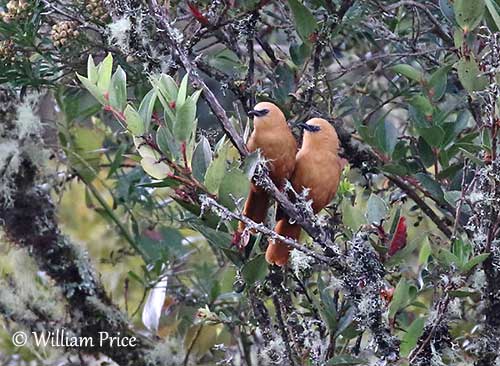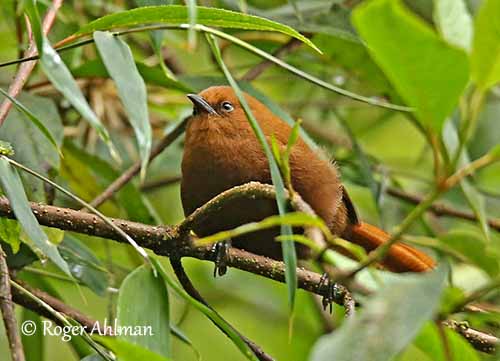
Fr: Troglodyte roux
Ang: Rufous Wren
All: Einfarb-Zaunkönig
Esp: Cucarachero Rufo
Ita: Scricciolo rossiccio
Nd: Rossige Winterkoning
Sd: Rostgärdsmyg
Photographers:
Roger Ahlman
Pbase Galleries Peru and Ecuador
Didier Buysse
Vision d’Oiseaux
William Price
PBase-tereksandpiper & Flickr William Price
Text by Nicole Bouglouan
Sources:
HANDBOOK OF THE BIRDS OF THE WORLD Vol 10 by Josep del Hoyo-Andrew Elliott-David Christie - Lynx Edicions - ISBN: 8487334725
BIRDS OF SOUTH AMERICA – Passerines - by Robert S. Ridgely and Guy Tudor – HELM Field Guides – ISBN: 9781408113424
WRENS, DIPPERS AND THRASHERS by Brewer David – illustrated by Barry Kent Mackay- Yale University Press - ISBN: 0300090595
Neotropical Birds – Cornell Lab of Ornithology
Wikipedia, the free encyclopaedia
Rufous Wren
Cinnycerthia unirufa
Passeriformes Order – Troglodytidae Family
INTRODUCTION:
The four members of the genus Cinnycerthia are confined to moist montane forests in Venezuela, Ecuador and Peru. This species is common in suitable habitat.
The Rufous Wren is gregarious and often seen in small groups of up to 20 birds, but usually in smaller parties.

DESCRIPTION OF THE BIRD:
Biometrics:
Length: 16-17 cm
Weight: 21-29 g
The adult of the nominate race has chestnut-brown to rufous-brown plumage overall.
On the head, crown and ear-coverts are orange-brown with paler area above the upper base of the bill. Lores and indistinct malar stripe are greyish-black.
The plumage colour becomes deeper on nape and shoulders, whereas it is brighter and mostly reddish on lower back and rump. On the upperwing, primaries and secondaries are darker chestnut-brown on the outer webs, and finely barred blackish. On the tail, the rectrices are reddish-brown with numerous darker, but inconspicuous, bars.
On the underparts, the chin is paler, mostly creamy-white. The breast is pale orange-brown, brighter on belly and vent. The underwing is chestnut-brown.
Bill, legs and feet are black. The eyes are brown.
Both adults are similar.
The juvenile resembles adults but it lacks the tail and wing’s barring.
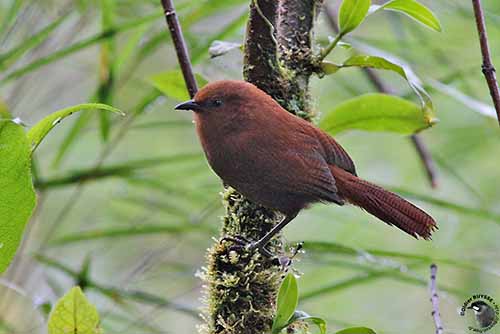
SUBSPECIES AND RANGE:
The Rufous Wren has three subspecies.
C.u. chakei is found on the border Venezuela – Colombia in the Sierra de Perijá. This race has similar appearance than nominate but the eyes are grey to whitish.
C.u. unibrunnea occurs in Colombia W of Río Magdalena, S through central Ecuador to N Peru (Piura, Cajamarca). This one is darker and duller than nominate.
C.u. unirufa (described above) is found in extreme W Venezuela and Colombia, E of Río Magdalena (S to Cundinamarca).
HABITAT:
The Rufous Wren frequents humid montane forest and edges, from 2200 metres to 3800 metres in shrub forest. It is often associated to Chusquea bamboo.
This species usually frequents the dense undergrowth of forests.
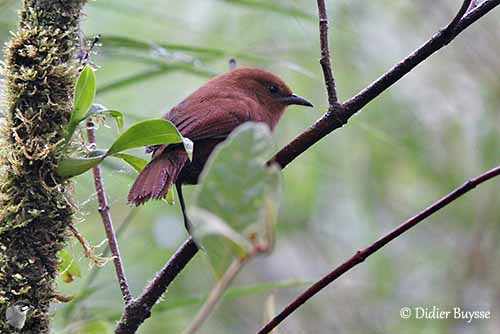
CALLS AND SONGS: SOUNDS BY XENO-CANTO
The Rufous Wren’s call is a soft “churr” or a short “whit-whit”. In defence behaviour, it gives loud, harsh “geea”.
The musical song is complex and consists of repeated single notes, trills or short phrases, often delivered in duet with other birds of the group which utter “whit-whit” notes, but also in chorus by several birds, something like “chew-tu, chew-tu, whoo-he…”
BEHAVIOUR IN THE WILD:
The Rufous Wren feeds probably exclusively on invertebrates. It forages in low vegetation or on the ground by turning over the leaf litter with quick and nervous movements.
It may sometimes follow mixed-species flocks or it forages alone.
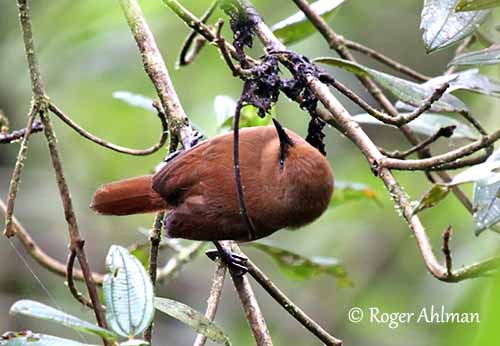
REPRODUCTION OF THIS SPECIES:
The birds of the race “chakei” are in breeding conditions between June and August, and a juvenile of the race “unibrunnea” was observed in March in SW Colombia.
Information about the breeding behaviour of this species is currently lacking, but it is probably fairly similar to that of the Peruvian Wren (C. peruana) which builds a globular suspended nest with woven rootlets and moss, and with an entrance hole.
The Rufous Wren is suspected to breed co-operatively with helpers at nest.
PROTECTION / THREATS / STATUS:
The Rufous Wren can be common in suitable habitat and it occurs in protected areas and National Parks throughout the range. This species is probably threatened by habitat destruction and fragmentation involving decline of the population.
But currently, the Rufous Wren is evaluated as Least Concern.
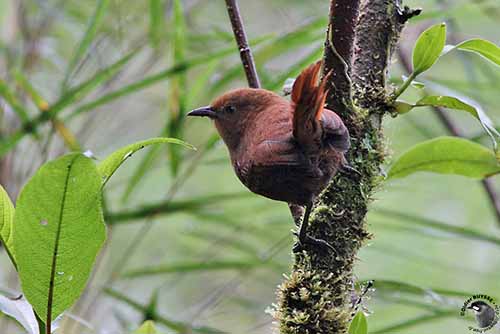
During the breeding season, both mates sing and duet while sitting side by side.
As a gregarious species often seen in small groups, the Rufous Wren is suspected to perform co-operative breeding.
In territorial defence, it becomes aggressive and adopts threatening postures with slightly drooped fanned wings and partially fanned tail. Usually, the bill is pointed towards the intruder.
The Rufous Wren is apparently sedentary in its range.
It remains in the dense cover and performs short flights among the vegetation.
